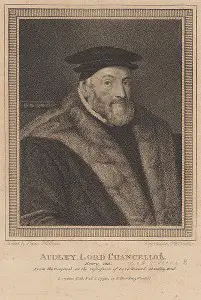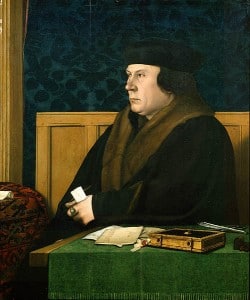
On this day in history, the 24th April 1536, Sir Thomas Audley, Henry VIII’s Lord Chancellor and Thomas Cromwell’s right hand man, set up two commissions of oyer and terminer at Westminster.
What’s an oyer and terminer?
Here is the definition of “oyer and terminer” from wikipedia:-
“Oyer and terminer is a term originating in English law for one of the commissions by which a judge of assize sat used for the extraordinary prosecution of criminal offences, particularly those of a serious nature. The term derives from Law French, meaning to hear and determine and was also known as audiendo et terminando.
By the commission of oyer and terminer the commissioners (in practice the judges of assize, though other persons were named with them in the commission) were commanded to inquiry and prosecute all treasons, felonies and misdemeanours committed in the counties specified in the commission. The inquiry was by means of the grand jury; after the grand jury had approved the bills of indictment submitted to it, the commissioners proceeded to hear and determine by means of the petit jury. The words oyer and terminer were also used to denote the court which had jurisdiction to try offences within the limits to which the commission of oyer and terminer extended.”1
What were these commissions for?

The two commissions of oyer and terminer that Audley set up were for offences committed in the counties of Middlesex and Kent and their job was to investigate alleged crimes and determine if there was indeed a case. Alison Weir, in The Lady in the Tower: The Fall of Anne Boleyn, writes of how these commissions “were rare, and were only instituted in serious cases, of which there were only seventeen in Henry VIII’s reign.” 2 Alison Weir also notes that this fact “together with the citing of the counties in which the Queen’s alleged offences were said to have been committed, shows that this commission was specifically appointed to examine the evidence against her.” 3
In The Life and Death of Anne Boleyn, Eric Ives notes that Henry VIII’s signature was not on the patent of the oyer and terminer and that the commissions may not have been ordered by the King, but rather Cromwell and Audley. Both Weir and Ives also note that a commission of oyer and terminer was usually only issued after the person accused of the crimes had been arrested. For example, an oyer was not issued against Sir Thomas More until he had undergone eight weeks of interrogation. So, why appoint these two commissions? Alison Weir writes:-
“In this case, however, it was issued beforehand, probably to avoid the usual delay of about eleven days, which suggests that Cromwell, fearing (with good reason, given Henry and Anne’s past history) that the King might succumb again to his “great folly” over his wife and dispute the evidence, was aware of the need to secure a speedy conviction.” 4
Eric Ives writes that:-
“A more sinister motivation could be that an oyer commission would be required if commoners were to be dealt with as well as the Queen” 5
and also acknowledges Cromwell’s need for speed in handling the case against the Queen and the men:-
“With a commission to hand process could start at once, allowing no possibility of second thoughts while examinations were conducted. Condemnation could be achieved in as little as four days.” 6
The Beginning of the End
In his book “Anne Boleyn”, Paul Friedmann writes of how the commissions of oyer and terminer were “virtually a death warrant for Anne” 7 but G W Bernard disputes this, saying:-
“As late as 25 April Henry was sending instructions to his ambassador at Rome, Richard Pate, insisting on the justice of his case for the divorce from Catherine. I used to think that the setting up of commissions of oyer and terminer on 24 April indicated that by then something was wrong, but I am now persuaded that there is no reason to suppose that these largely conventional commissions need have been set up with Anne in mind. Similarly I am not now sure that the summoning of Parliament on 27 April, barely two weeks after the dissolution of the reformation parliament on 14 April, reflects the need to deal with Anne Boleyn…Right up to the moment of Anne’s arrest, then, there is little to show that Henry was anything but fully committed to his marriage.” 8
What do you think? Are Weir and Friedmann correct in seeing the commissions as the beginning of the end for Anne Boleyn, or could Bernard be right, were these commissions set up for another reason?
Notes and Sources
1 – Wikipedia – Definition of “oyer and terminer”
2 – The Lady in the Tower: The Fall of Anne Boleyn, Alison Weir, p89
3 – Ibid., p89
4 – Ibid., p89
5,6 – The Life and Death of Anne Boleyn, Eric Ives, p323
7 – Anne Boleyn, P. Friedmann, p228, 2010 edition edited by Josephine Wilkinson.
8 – Anne Boleyn: Fatal Attractions, G W Bernard, p134
 P.S. G W Bernard’s book “Anne Boleyn: Fatal Attractions” has been released early and is available now at Amazon UK – click here. They ship worldwide so you don’t have to wait. I’ve nearly finished it so I’ll be giving you my thoughts next week.
P.S. G W Bernard’s book “Anne Boleyn: Fatal Attractions” has been released early and is available now at Amazon UK – click here. They ship worldwide so you don’t have to wait. I’ve nearly finished it so I’ll be giving you my thoughts next week.
P.P.S. We have one original Anne Boleyn ACEO size painting by artist Geri Centonze available on the shop. It’s an original so there’s only one – grab it while you can! Click the picture for details.